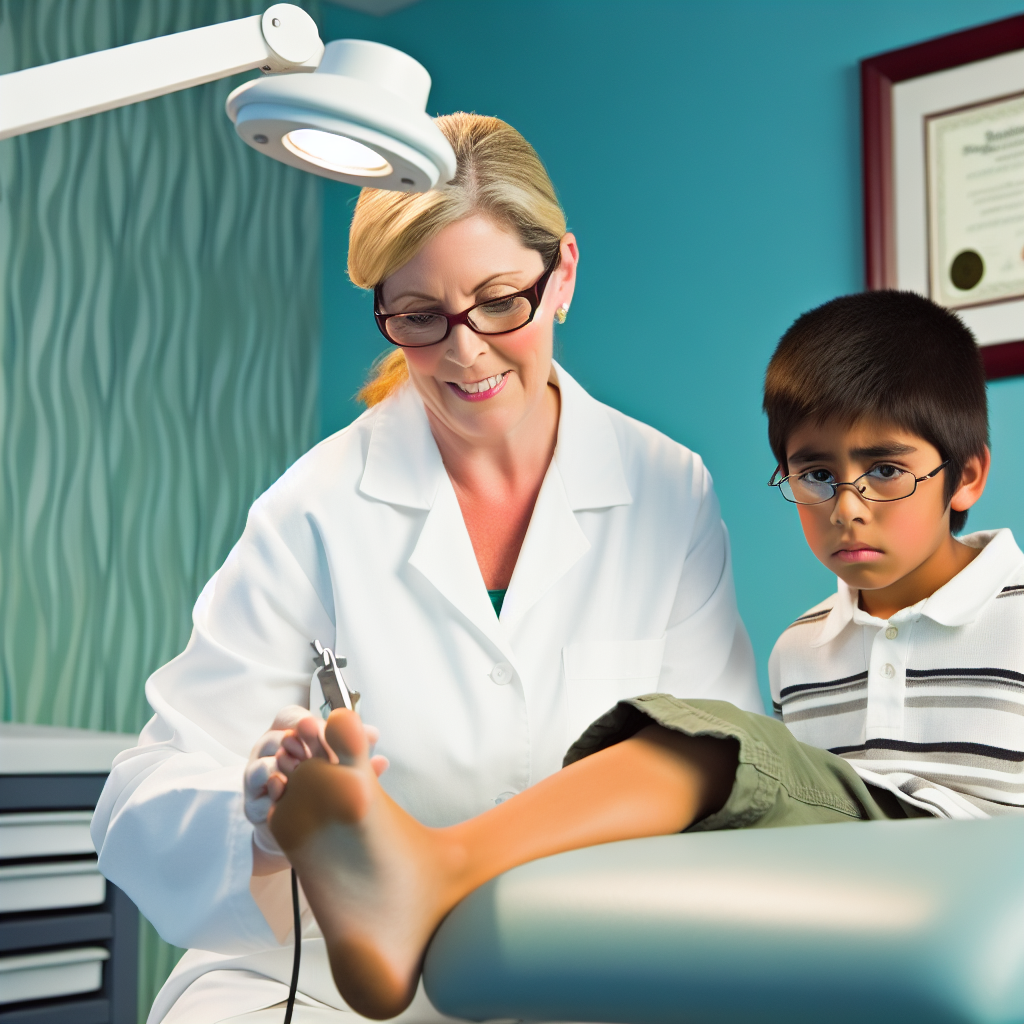Understanding Pediatric Foot Development and Growth Patterns
The Importance of Early Development
Pediatric foot development is crucial for a child’s overall health.
During the first few years, a child’s feet undergo significant changes.
Proper foot development supports walking and physical activity.
Moreover, it establishes a foundation for future mobility and balance.
Key Stages of Growth
The growth of children’s feet occurs in distinct stages.
Infants have soft and flexible feet that gradually develop strength.
As toddlers begin to walk, their foot structure adapts to new movements.
In early childhood, the arches begin to form, providing support.
By adolescence, feet approach their adult size and shape.
Common Pediatric Foot Issues
Many children experience foot-related issues during development.
Flat feet are a common concern among young children.
Furthermore, conditions like ingrown toenails can also arise.
It’s essential for parents to recognize signs of discomfort.
The Role of Podiatrists in Pediatric Foot Care
Podiatrists play a vital role in managing pediatric foot issues.
They provide assessments to diagnose conditions early.
Additionally, they recommend appropriate footwear and orthotics.
Podiatrists also educate families about proper foot hygiene.
Early intervention can significantly improve outcomes for children.
Family Involvement in Foot Health
Families should be proactive in monitoring their child’s foot health.
Regular check-ups with a podiatrist are beneficial.
Parents can also help by choosing supportive footwear for their children.
Encouraging foot exercises can enhance strength and flexibility.
Moreover, maintaining proper hygiene prevents common issues.
Common Pediatric Foot Conditions Treated by Podiatrists
Flat Feet
Flat feet, or pes planus, commonly affect children.
Many kids experience this condition as they grow.
Unlock Your Career Potential
Visualize a clear path to success with our tailored Career Consulting service. Personalized insights in just 1-3 days.
Get StartedPodiatrists evaluate the arch’s development over time.
They provide support when necessary to improve function.
Ingrown Toenails
Ingrown toenails occur when the nail grows into the skin.
This condition can cause pain and swelling.
Children often develop this issue due to improper nail trimming.
Podiatrists assess the severity and recommend treatment options.
Sever’s Disease
Sever’s disease is a common cause of heel pain in kids.
This condition results from inflammation of the growth plate.
Active children often experience discomfort during sports.
Podiatrists can suggest rest and heel lifts for relief.
Warts
Foot warts, caused by the human papillomavirus, can be bothersome.
They often appear on the soles of children’s feet.
Podiatrists use various methods to remove warts effectively.
Treatment may include cryotherapy or topical medications.
Knock Knees
Knock knees, or genu valgum, is when knees touch while standing.
This condition often resolves naturally as children grow.
However, some children may require intervention.
Podiatrists can recommend exercises to improve alignment.
Plantar Warts
Plantar warts can be painful and affect walking.
They form on the soles due to virus exposure.
Podiatrists offer treatments to reduce pain and remove warts.
These options may include laser therapy or topical treatments.
Fungal Infections
Fungal infections like athlete’s foot can affect children.
This condition causes itching and discomfort.
Podiatrists diagnose the infection and recommend antifungal treatments.
Proper hygiene and footwear are essential for prevention.
The Role of Podiatrists in Diagnosing Flat Feet in Children
Importance of Early Diagnosis
Early diagnosis of flat feet is crucial for children’s development.
Podiatrists play a significant role in identifying these conditions.
They perform thorough examinations to assess foot structure and function.
Moreover, timely intervention can prevent further complications.
Symptoms and Indicators
Children with flat feet may show specific symptoms.
Pain in the feet, ankles, or knees is common among them.
Additionally, they may experience difficulty in walking or running.
Parents should be vigilant about these indicators.
Podiatrists can offer expert evaluations when these symptoms arise.
Evaluation Techniques
Podiatrists employ various techniques to diagnose flat feet effectively.
Physical examinations include checking the arch height and foot flexibility.
They may also use imaging techniques, such as X-rays.
These methods provide a clear picture of the foot structure.
Ultimately, these evaluations help in creating tailored treatment plans.
Customized Treatment Plans
Once diagnosed, podiatrists develop personalized treatment plans.
These plans may include exercises to strengthen foot muscles.
In some cases, supportive footwear or orthotics is recommended.
Podiatrists educate parents about proper foot care practices.
Regular follow-ups are essential to monitor progress and adjust plans.
Explore Further: Chiropractic Techniques For Pain Management
Treatment Options for Pediatric Plantar Warts and Other Skin Conditions
Understanding Pediatric Plantar Warts
Pediatric plantar warts are benign growths on the soles of children’s feet.
They often result from viral infections, specifically the human papillomavirus (HPV).
Children can contract warts by walking barefoot in public spaces.
Generally, these warts are not harmful but may cause discomfort.
Common Treatments for Plantar Warts
Treatment options vary based on the wart’s size and severity.
Over-the-counter treatments are often the first line of defense.
- Salicylic acid is a common topical treatment.
- Freezing the wart with cryotherapy is another effective method.
- Physicians may also suggest laser therapy for persistent cases.
Home Remedies for Plantar Warts
Some parents prefer home remedies for treating plantar warts.
These can include duct tape occlusion therapy.
Additionally, some use vinegar or essential oils, though effectiveness may vary.
It’s crucial to monitor the wart’s progress closely.
Treating Other Skin Conditions
Other common skin conditions in children include athlete’s foot and eczema.
These conditions may also require specialized treatment.
Topical antifungal creams are effective against athlete’s foot.
For eczema, moisturizing creams can alleviate symptoms.
When to Consult a Podiatrist
Consulting a podiatrist is essential for persistent or painful conditions.
They can provide tailored treatment plans and medical intervention.
Podiatrists are also valuable for education on proper foot hygiene.
Early treatment can prevent complications in more serious cases.
Gain More Insights: How Chiropractors Address Workplace-Related Injuries
Podiatric Interventions for Athletic Injuries in Young Athletes
Importance of Early Intervention
Early intervention is crucial for young athletes facing foot injuries.
Podiatrists play a key role in assessing and treating these issues.
Quick diagnosis helps prevent complications and long-term problems.
Common Athletic Injuries in Youth
Younger athletes often experience specific foot injuries.
Common injuries include sprains, fractures, and tendonitis.
These injuries can result from improper footwear or training techniques.
Assessment and Diagnosis
Podiatrists begin with a thorough assessment of the athlete’s condition.
They analyze symptoms to identify the type of injury present.
Diagnostic tools like X-rays and MRI can provide valuable insights.
Customized Treatment Plans
Each athlete requires a tailored treatment plan based on their condition.
Podiatrists may recommend rest, ice, compression, and elevation.
Moreover, they can suggest specific exercises to strengthen the foot.
Orthotics and Supportive Devices
Orthotic devices can greatly enhance recovery for young athletes.
Podiatrists often prescribe custom orthotics to provide support.
These devices help in realigning the foot and distributing pressure evenly.
Rehabilitation and Prevention
Rehabilitation is vital for a full recovery.
Podiatrists guide young athletes through their rehabilitation journey.
Preventative strategies are also implemented to reduce future injury risks.
Education and Awareness
Podiatrists educate young athletes about proper foot care.
They inform athletes and parents about suitable shoes and training methods.
Awareness can significantly decrease the likelihood of injuries.
Learn More: The Growing Demand for Kinesiologists in Health Care

The Importance of Early Detection and Intervention in Pediatric Foot Problems
Early detection of foot issues in children is crucial for effective treatment.
Children’s feet undergo significant changes as they grow and develop.
Identifying problems early can prevent more severe complications later in life.
Podiatrists play a key role in assessing and managing pediatric foot issues.
Parents should be aware of common foot problems that affect children.
Common Pediatric Foot Issues
Flat feet are a frequent concern in young children.
Some children may also experience ingrown toenails or bunions.
Other issues include plantar warts and heel pain.
These conditions can impact a child’s mobility and overall well-being.
Signs Parents Should Look For
Parents should observe if their child complains of foot pain.
Difficulty walking or changes in walking patterns may signal problems.
Swelling or redness can also indicate underlying issues.
It is essential to consult a podiatrist if these signs are present.
The Role of Podiatrists in Treatment
Podiatrists provide comprehensive examinations to identify foot problems.
They recommend treatment plans tailored to each child’s needs.
Treatment options may include orthotics to support proper foot alignment.
Physical therapy can also help improve strength and flexibility.
The Long-Term Benefits of Early Intervention
Addressing foot issues early can lead to improved mobility.
It reduces the risk of further complications and chronic pain.
Additionally, it promotes healthy foot development as children grow.
Ultimately, early intervention aids in a child’s overall quality of life.
Learn More: Career Pathways For Speech-Language Pathologists
Collaboration Between Podiatrists and Other Healthcare Professionals for Optimal Care
Importance of Interdisciplinary Teams
Podiatrists play a vital role in pediatric healthcare.
They collaborate closely with various healthcare professionals.
This teamwork enhances the quality of care for children.
Effective communication is key to successful collaboration.
Families benefit from a comprehensive treatment approach.
Roles of Pediatricians
Pediatricians assess overall health in children.
They are often the first to notice foot-related issues.
Regular check-ups facilitate early detection of problems.
Pediatricians refer cases to podiatrists when necessary.
This referral ensures specialized treatment and management.
Physical Therapists and Rehabilitation
Physical therapists aid in rehabilitation programs.
They focus on strength building and improving mobility.
Podiatrists provide input on foot-specific exercises.
This collaboration enhances recovery from foot injuries.
Working together, they design personalized therapy plans.
Orthopedic Surgeons and Specialists
Orthopedic surgeons address complex foot conditions.
Podiatrists often provide conservative treatment options first.
They may suggest surgery when necessary.
Collaboration leads to better surgical outcomes.
Post-operative care is crucial, requiring teamwork.
Parents as Partners in Care
Parents play a significant role in their children’s health.
Education provided by podiatrists helps parents understand issues.
Families can better manage care with provided resources.
Open communication keeps everyone informed.
This partnership improves adherence to treatment plans.
Community Involvement
Podiatrists often engage in community outreach programs.
They educate the public about pediatric foot health.
Such initiatives raise awareness of common foot problems.
Collaboration with schools can promote preventive care.
Community events may provide free screenings for children.
Patient Education: Teaching Children and Parents About Foot Health
Importance of Foot Health
Foot health significantly impacts children’s overall well-being.
Healthy feet support active lifestyles and physical development.
Parents should understand the role of proper footwear in foot health.
Common Pediatric Foot Issues
Many children experience common foot issues like flat feet and in-toeing.
Parents must recognize signs of foot problems early on.
Sometimes, children may not express discomfort, so vigilance is key.
Educating Children About Their Feet
Teaching children about their feet helps foster awareness.
Start with fun stories or colorful charts about foot anatomy.
Make it interactive by asking them to identify their foot parts.
Engagement Strategies for Parents
Parents can learn about foot health during pediatric visits.
Regularly consult with podiatrists for preventive care advice.
Encourage parents to ask questions regarding their child’s foot health.
Choosing the Right Footwear
Footwear plays a vital role in maintaining healthy feet.
Parents should opt for shoes that fit well and offer proper support.
Children should be involved in selecting their shoes for comfort.
Regular Foot Check-Ups
Annual foot check-ups can detect early signs of issues.
Podiatrists can give valuable recommendations for foot care.
Scheduling routine visits promotes lifelong foot health awareness.
Encouraging Healthy Foot Practices
Teach children to wash their feet regularly and dry them thoroughly.
Encourage them to wear appropriate footwear for different activities.
Highlight the importance of stretching feet before engaging in sports.
Additional Resources
What’s The Difference Between A Podiatrist And A Chiropodist?




